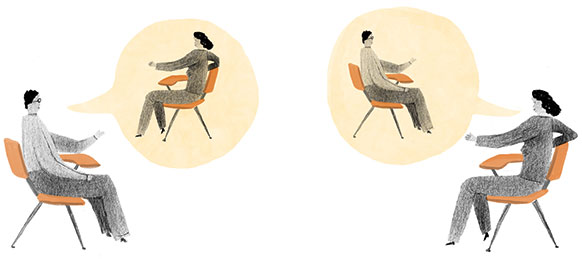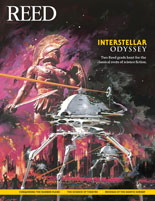
IRIS login | Reed College home Volume 94, No. 1: March 2015
The Art and Craft of Teaching

illustration by lilli carrÉ
Reed profs sharpen pedagogical skills at Center for Teaching and Learning
By Randall S. Barton
Reed has long been synonymous with excellent teaching. With its small classes, low student-faculty ratio, and spirit of intellectual inquiry, it’s the kind of place where professors enjoy a near-mythological status. But, as Prof. Morgan Luker [music 2010–] observes, “Great teachers are not born, they’re made.”
Prof. Luker is one of the professors excited about the new Center for Teaching and Learning (CTL), which opened in September in the remodeled Greywood building.
“The center is a genuine home run,” says Nigel Nicholson, dean of the faculty and Walter Mintz Professor of Classics [1995–]. “It has generated real excitement and is already a wonderful resource for continuing and senior faculty as well as new faculty. Above all, it helps us frame teaching as a craft or practice rather than a gift.”
Historically, Reed’s intimate scale and collegial atmosphere have allowed professors to swap ideas and learn techniques from one another. But advances in technology—plus new research in education—have given all professors a chance to sharpen their game.
“Many faculty members are very friendly towards each other and converse a lot in the hallway and between classes,” says Prof. Sonia Sabnis [classics 2006–]. “But we didn’t have anything institutional for the support of teaching. If for some reason your teaching goes awry or you have an issue, it’s been hard to know where to go for help. The center has provided an environment to talk about teaching—both problems and triumphs—and share ideas in a systematic way.”
The Mellon Foundation provided funding for a pilot project where Reed professors investigated teaching and learning programs at other colleges, digested their findings, and compiled a report.
Daniel Kemp ’58, professor emeritus of chemistry at Massachusetts Institute of Technology, is providing current funding for the programming at the center.
“When I was a graduate student at Princeton you learned the content of what you were going to teach,” says Prof. Kathy Oleson [psychology 1995–], the director of the center. “In many graduate schools the focus was research . . . . But if you value teaching, it’s not enough to say, ‘I know psychology.’ You have to be able to teach it to someone else.”
The center hosts programs and seminars on a variety of topics, such as effective conference participation, supporting students with disabilities, and how to put together a syllabus. Professors teaching the same courses year after year can discover strategies to keep the material fresh for their students—and for themselves.
Prof. Jonathan Rork [economics 2010–] serves on the center’s advisory council and is investigating a program of formalized student peer advising.
“Students would share their experience of how to get the most from this new and challenging experience,” he says. “By formalizing it, we insure that everyone has access, that it isn’t limited to random discussions in the residence halls.”
At Brown University, Rork was a student adviser in the Meiklejohn program, meeting with advisees at the same time as their faculty adviser.
He envisions that Reed faculty would choose student academic advisers to work alongside them for key events like freshman orientation and junior quals.
“The faculty member would work through the nuts and bolts of the program and then I would chime in when they had questions,” he explains.
In their early years it can be difficult for junior faculty, who come from a range of backgrounds, to adjust to the culture at Reed, particularly the conference method, which may be unfamiliar to professors who hail from research universities.
“I didn’t understand what a liberal arts education really was until I started to experience it,” says Prof. Kara Becker [linguistics 2010–]. “Teaching is the central thing we do, but there aren’t always opportunities to work on improving what you do in the classroom.”
One program pairs professors with students to provide feedback on the classroom experience. (As with all the center’s programs, participation is voluntary.)
Student-consultants monitor professors’ classes; compile detailed, minute-by-minute accounts of what transpires; and offer thoughts and suggestions, such as: “You asked a question and nobody responded. Was it because no one had done the reading? Or was the question too broad?” or “This was great, the students seemed excited here.”
In the first semester, Prof. Becker collaborated with Julia Selker ’15, and Prof. Luker with Ben Morris ’15.
“You work really hard on what you planned for class and you want it to go well,” Becker says. “When it ends, you feel something about it. Maybe it went well; maybe it was a disaster. Having that second pair of eyes to confirm or deny how things went is amazing.”
Julia agrees. “Experiencing a class from this perspective, I think of a gazillion things that I would never have noticed as a student, and probably not as a professor,” she says. “I didn’t expect to be so excited about the possibility of changing things and exploring different techniques. Kara never shies away from more effort. She has a lot of goals she wants to accomplish and it makes teaching feel like such an adventure.”
Neither Ben nor Julia major in the courses they evaluated, allowing them to observe classroom dynamics without having to focus on content. Ben is a psychology major and Julia majors in physics.
Each week they meet with their respective teachers to discuss which aspects of class to pay attention to, how lectures flowed, and whether students struggled with aspects of discussion or the formulation of a question.
“I watch not only what Morgan is doing, but how engaged the students are, their body language, and how certain exercises are being responded to,” Ben says.
Luker admits that working with a student to improve his pedagogy was risky in terms of his ego. But the experience has given him new insights and encouraged him to try new techniques, such as breaking the class into smaller groups for discussion.
“There is a lot to learn, but we don’t have to reinvent the wheel,” he says. “This program was taken from other models that work. Some of the professors participating in it are bulletproof, famously among the best teachers here. It’s about continuing development. This has been tremendously valuable. I would do it for every class I had, if I could.”
For his part, Ben has gained a new appreciation for how much work a professor does on a day-to-day basis.
“If a professor is communicating the information effectively, it doesn’t feel like teaching is this big action that is carefully crafted and consciously put together,” Ben says. “But in large respect, it is. It’s astounding the consciousness Morgan needs in thinking about what he’s doing, and saying it well while teaching the content.”
Enthusiasm is running high during CTL’s second semester; with more than 40 faculty signed up for learning seminars and 15 collaborations between professors and student consultants.

LATEST COMMENTS
steve-jobs-1976 I knew Steve Jobs when he was on the second floor of Quincy. (Fall...
Utnapishtim - 2 weeks ago
Prof. Mason Drukman [political science 1964–70] This is gold, pure gold. God bless, Prof. Drukman.
puredog - 1 month ago
virginia-davis-1965 Such a good friend & compatriot in the day of Satyricon...
czarchasm - 4 months ago
John Peara Baba 1990 John died of a broken heart from losing his mom and then his...
kodachrome - 7 months ago
Carol Sawyer 1962 Who wrote this obit? I'm writing something about Carol Sawyer...
MsLaurie Pepper - 8 months ago
William W. Wissman MAT 1969 ...and THREE sisters. Sabra, the oldest, Mary, the middle, and...
riclf - 10 months ago